Accept all cookies Accept only essential cookies See our Cookie Notice

About ESA
The European Space Agency (ESA) is Europe’s gateway to space. Its mission is to shape the development of Europe’s space capability and ensure that investment in space continues to deliver benefits to the citizens of Europe and the world.
Highlights
ESA - United space in Europe
This is ESA ESA facts Member States & Cooperating States Funding Director General Top management For Member State Delegations European vision European Space Policy ESA & EU Space Councils Responsibility & Sustainability Annual Report Calendar of meetings Corporate newsEstablishments & sites
ESA Headquarters ESA ESTEC ESA ESOC ESA ESRIN ESA EAC ESA ESAC Europe's Spaceport ESA ESEC ESA ECSAT Brussels Office Washington OfficeWorking with ESA
Business with ESA ESA Commercialisation Gateway Law at ESA Careers Cyber resilience at ESA IT at ESA Newsroom Partnerships Merchandising Licence Education Open Space Innovation Platform Integrity and Reporting Administrative Tribunal Health and SafetyMore about ESA
History ESA Historical Archives Exhibitions Publications Art & Culture ESA Merchandise Kids Diversity ESA Brand Centre ESA ChampionsLatest
Space in Member States
Find out more about space activities in our 23 Member States, and understand how ESA works together with their national agencies, institutions and organisations.
Science & Exploration
Exploring our Solar System and unlocking the secrets of the Universe
Go to topicAstronauts
Missions
Juice Euclid Webb Solar Orbiter BepiColombo Gaia ExoMars Cheops Exoplanet missions More missionsActivities
International Space Station Orion service module Gateway Concordia Caves & Pangaea BenefitsLatest
Space Safety
Protecting life and infrastructure on Earth and in orbit
Go to topicAsteroids
Asteroids and Planetary Defence Asteroid danger explained Flyeye telescope: asteroid detection Hera mission: asteroid deflection Near-Earth Object Coordination CentreSpace junk
About space debris Space debris by the numbers Space Environment Report In space refuelling, refurbishing and removingSafety from space
Clean Space ecodesign Zero Debris Technologies Space for Earth Supporting Sustainable DevelopmentLatest
Applications
Using space to benefit citizens and meet future challenges on Earth
Go to topicObserving the Earth
Observing the Earth Future EO Copernicus Meteorology Space for our climate Satellite missionsCommercialisation
ESA Commercialisation Gateway Open Space Innovation Platform Business Incubation ESA Space SolutionsLatest
Enabling & Support
Making space accessible and developing the technologies for the future
Go to topicBuilding missions
Space Engineering and Technology Test centre Laboratories Concurrent Design Facility Preparing for the future Shaping the Future Discovery and Preparation Advanced Concepts TeamSpace transportation
Space Transportation Ariane Vega Space Rider Future space transportation Boost! Europe's Spaceport Launches from Europe's Spaceport from 2012Latest

Hera and its asteroid target
Thank you for liking
You have already liked this page, you can only like it once!
ESA’s Hera mission for planetary defence seen approaching the Dimorphos asteroid moonlet, which is destined to become the subject of an audacious deflection experiment.
The newly-named Dimorphos – at 160 m across, about the size of Egypt’s Great Pyramid – orbits around the main 780 m mountain-sized Didymos near-Earth asteroid. Next year NASA’s Double Asteroid Redirection Test (DART) will leave Earth and in October 2022 will perform a kinetic impact with Dimorphos, in an attempt to deflect its orbit.
Then in 2024 ESA’s Hera spacecraft will set off to perform a close-up investigation of the result: the sole object in the Solar System to have had its orbit shifted by humankind in a measurable way.
By gathering details of Dimorphos’s mass, composition and the crater left by DART, Hera – along with the two CubeSats it will carry with up, for close-up views – will let researchers assess the effectiveness of the deflection technique in as full a manner as possible, enabling its reuse if needed against an oncoming asteroid.
Hera will also return plentiful bonus science, with its Juventas CubeSat performing the first radar survey of an asteroid’s interior, demonstrate inter-satellite link technology in deep space and provide experience of ultra-low gravity operations.
Given the go ahead at ESA’s Space19+ Ministerial Council last November, Hera is set to undergo its preliminary design review in the autumn.
This month, ESA is celebrating the UN-recognised Asteroid Day, to inspire the world about asteroids and their role in the formation of our solar system, how we can use their resources, how asteroids can pave the way for future exploration and how we can protect our planet from asteroid impacts. More information, and a month of programming, via asteroidday.org
-
CREDIT
OHB -
LICENCE
ESA Standard Licence

Hera and its CubeSats at Didymos system

Hera approaching Didymos asteroids

Dimorphos asteroid to scale with Rome's Colosseum

Mini-radar for asteroid CubeSat















 Germany
Germany
 Austria
Austria
 Belgium
Belgium
 Denmark
Denmark
 Spain
Spain
 Estonia
Estonia
 Finland
Finland
 France
France
 Greece
Greece
 Hungary
Hungary
 Ireland
Ireland
 Italy
Italy
 Luxembourg
Luxembourg
 Norway
Norway
 The Netherlands
The Netherlands
 Poland
Poland
 Portugal
Portugal
 Czechia
Czechia
 Romania
Romania
 United Kingdom
United Kingdom
 Slovenia
Slovenia
 Sweden
Sweden
 Switzerland
Switzerland

























